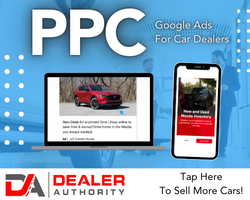You Can’t Cut Your Way to Market Share Growth
It’s a flattening vehicle market – I get it – but, you simply cannot cut your way to market share growth. Of course, you also can’t keep throwing money at some shiny marketing widget just because everyone claims it’s the coolest thing ever.
For dealers with questionable (or especially no) tracking and measurement of their digital marketing spend, the desire to make deep and painful budget cuts as the market softens will always win over any rational thinking about what it takes to conquest sales and grow share.
(Yes, you can and should work to grow share in any market, but especially in a soft or down market.)
Before digital marketing was a thing, dealers often said “I know half my advertising is working; I just don’t know which half.” Then, digital marketing brought with it the ability to track and measure virtually every interaction with a prospect – up to and including the sale – and promising to give dealers real insight into their advertising spend.
Yet today, most dealers will tell you that they know half their digital marketing is working; they just don’t know which half.
Unfortunately for these dealers and especially for their effective lead-driving vendors; when faced with market softness, dealers begin cutting what they perceive as fat. As we know from history, much of what will be cut will, regrettably, be bone.
You’re Not Thinking Clearly if You Cut Sources Delivering Sales Leads
Cutting back on any digital marketer that drives measurable sales leads without first conducting solid ROI calculations (and ensuring your team is following simple, repeatable and effective internet sales processes) is simply foolish. In fact, it might be borderline idiotic.
There, I said it. Someone had to.
The market is softening and if you didn’t have a plan for this, you’ll likely begin to indiscriminately cut back on digital marketing. The problem, of course, is not that you’re finally getting control of this budget, but that you might be eliminating genuine sales leads submitted by real prospects that truly want to buy cars from you… all to “rein in” your marketing budget.
Measure Twice, Cut Once
Just like the advice given to a carpenter’s apprentice, the axiom of measure twice, cut once should apply to your admirable efforts to gain some control over your marketing budget. In other words, you should be certain of the impact of the cuts you’re making before you make them.
We witnessed indiscriminate cutting in the last market downturn: dealers and groups wiped out whole segments of their marketing spend when sales began to decline – and those who did, lost market share in the process. Of course, because there was little real ROI measurement happening then, effective sales lead sources were cast aside so that digital marketing managers and agencies could continue to spend on the cool and the shiny.
From boring website add-ons (like instant retargeting and effective trade-in tools) to third-party vendors (like AutoWeb); dealers who were looking to spend less jettisoned effective sources that were delivering a great ROI… they just didn’t know it, because they weren’t measuring the measurable.
The Case for Keeping Third-Party Leads
For those who’ve read my posts, you may know I’m a fan of casting a wide net when trying to grow market share. Though even beyond that, I absolutely love the flexibility of third-party leads when trying to conquest outside your PMA – whether in an up or down market.
When you apply measurement to the spend, there is no more efficient way to acquire, say, a Toyota Tundra prospect in a neighboring market than to do so with via an independent third-party lead provider that will allow you to target specific Models in specific ZIP Codes. Facebook comes close – and I recommend you keep Facebook in your marketing arsenal during slow times, as well – but, even Facebook can’t routinely deliver that ZIP Code-specific Tundra prospect for a $25 cost per lead.
CPL, CPS, and Cost as a Percent of Gross
There are three old-school ROI measurements I recommend you apply to your digital marketing sources in any market; but especially before you make budget cuts in a down market. These are Cost Per Lead (CPL), Cost Per Sale (CPS), and Cost as Percent of Gross.
While different sources will have different thresholds of these measurements that you’ll want to target, overall, you’ll want to maintain your cost as a percent of gross for your entire digital spend in the 20% or lower range. That is, you’ll want to ensure your total (front and back) gross is at least five times greater than your total marketing costs (for measurable digital sources).
Some sources (like expensive classifieds websites) will show higher CPL, CPS and Cost as a Percent of Gross than others (like a website add-on or third-party lead); though this doesn’t mean you’ll automatically cut the source with the highest CPL, for example. It does mean, however, that the most expensive sources will need greater scrutiny and perhaps a bit of negotiating (if you plan to bring their costs more in line with the rest of your spend).
Since you cannot cut your way to market share growth, using these old-school ROI measurements allows you to make smarter cuts when market softness dictates. While not perfect, they also allow you to rationally examine the latest shiny “must have” widget (in any market).
…
The Henry Ford quote we’ve all heard rings true even today: “A man who stops advertising to save money is like a man who stops a clock to save time.”
That said, some amount of your marketing budget will likely need to be cut if the market softness continues. The key for dealers who want to make smart cuts as they continue to grow market share is to, of course, track and measure as they focus on driving more genuine sales leads (and less of what everyone else thinks is the coolest thing ever).
Good selling!
Comments
[highlight color=”#f3b851″ font=”black”]
Join our Discussion in the Dealer Forums
[/highlight]









Current Discussion Topics